The Lowdown on Lobster

I am going to let you all in on a little secret which may probably shock you: I don’t love lobster like most folks. This may be an unpopular opinion, but that is where I stand! Lobster has always been regarded as a high class ingredient and it is often sought after but it is just not for me. Maybe this stems from working in a fine dining French restaurant that served lobster so much that I was cooking and cleaning about 50 plus a day. I can appreciate why people like lobster though; it can be presented beautifully in its shell, it has a buttery texture when cooked properly, and can take on any flavor profile you might what to pair with it.
For most home cooks, lobster can be a very daunting protein to attempt to cook. I want to demystify this luxurious ingredient and hopefully entice you with a delectable recipe for you to try at home even if you are scared of purchasing a whole live lobster.
Have you ever bought a live lobster from your grocery store tank?
Live vs. frozen: Although it’s possible to purchase frozen lobster tails or pulled lobster meat; live, whole lobsters have the best flavor. A dead lobster can start to become mushy within an hour due to enzymatic breakdown. Just like other shellfish, whole lobsters should be alive before cooking. To check if your lobster is alive and healthy, pick it up. It should move its claws, legs, and tail. Hold the lobster from its outer shell and make sure the lobster holds its claws above its head and they should not be drooping. Lobsters that don’t show signs of movement may be unhealthy and unfit to eat.
Hard-shell vs. soft-shell: Hard-shell lobsters and soft-shell lobsters aren’t different varieties of lobster; they are just at different stages of growth. Soft-shell lobsters are lobsters that have recently shed their old shells to make room for new ones. The newly-formed shells are thinner, so they’re easier to crack and pick. Since soft-shell lobsters have yet to grow into their new shells, you’ll find water in between the shell and the meat. Hard-shell lobsters, on the other hand, have a higher meat yield because they have grown into their shells. Since soft-shell lobsters do not ship well, you should only eat them locally.
Male vs. female: For cooking purposes, the differences between male and female lobsters are negligible. Female lobsters have roe, which may be used for making coral oil or as a garnish for dishes. Typically, though, fishermen release egg-bearing females to reproduce and keep the lobster population stable.
In general, look for lobsters on the smaller end of the scale. Whole lobsters’ range in size from one-and-a-quarter-pound “chicks” to jumbo lobsters (three to four pounds). In Maine, the minimum size for legal harvest is one pound, and some areas enforce a maximum size as well, to protect older, larger lobsters. Although large lobsters might look impressive, smaller lobsters are more affordable and cook more evenly. If you’re new to cooking with lobsters, choose small lobsters: one-and-a-quarter-pound lobsters will be the easiest to work with.
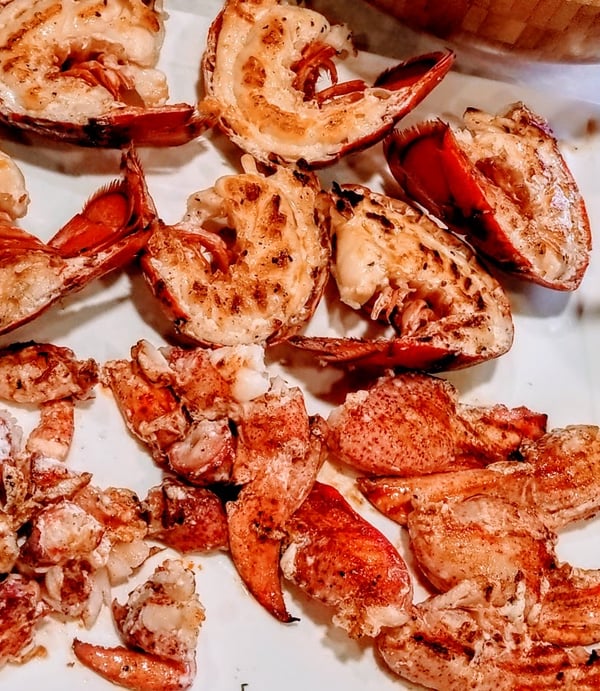 Par boiled and then grilled lobster
Par boiled and then grilled lobster
Where to Buy Live Lobster
As with any type of fresh seafood, when you’re buying lobster, it’s best to shop at a dedicated seafood market with high turnover. In the Northeast, it’s easy to find fish markets dedicated to selling locally-caught live lobsters but here in Illinois, that isn’t always the case. If your grocery store doesn’t sell fresh lobster, you can order fresh live lobster online directly from lobster companies. These will be hard-shell lobsters since soft-shell lobsters are too delicate to ship.
A pro tip to buying lobster at a grocery store: they will eat each other’s antennae. If you look into a holding tank at a grocery store, a lot of times you can tell if a lobster has been there for a long time because their antennae have been nibbled down right down to the base. You want to find lobsters that have very long antennae.
Preparing Live Lobster
There are a few schools of thought on how to initially kill your live lobster. Some believe it is more humane to use a chef’s knife to pierce into the top of the head of the lobster in between the eyes. While this may be an instantaneous method to render the lobster immobile, I find that it can be a bit dangerous. You could always put the lobster in the freezer, this will temporarily stun the lobster and make it easier to handle. My preferred method of cooking lobster is boiling or steaming them. Although, this process is still considered illegal in some areas of the world. For other tips on mistakes to avoid, check out this blog.
If you are looking to eat your lobster straight out of the shell with some drawn butter, you will want to boil it for at least 8-9 minutes for a 1-pound lobster. You will add on 1-2 minutes for every quarter pound more. So a 1.5 pound lobster would take about 11-12 minutes. This time will ensure that the lobster is cooked through but not overcooked and tough.
If you are going to grill your lobster, or are planning to take the meat out of the shell and cook again in some way, like a risotto for example, I suggest cutting that time in half. This way, the lobster is cooked enough that it releases from the shell easily but will not be cooked through and you can finish the cooking process and still achieve a wonderful texture.
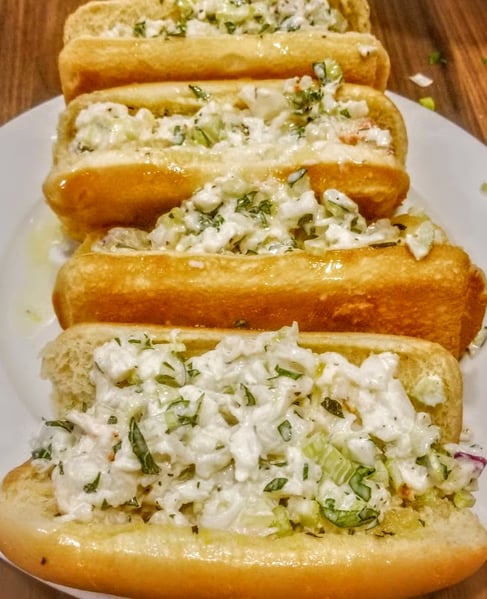 Fully boiled lobster for lobster rolls
Fully boiled lobster for lobster rolls
Lobster Tails
If the idea of purchasing a whole lobster still seems scary, don’t fret! Lobster tails are a fantastic way to dip into the lobster pool. The first thing you have to know when buying lobster tail is that while there are a lot of species of lobster all over the world, when it comes to buying frozen lobster tails, the two basic options are warm-water lobster and cold-water lobster. Most of the tails you find available at grocery stores, and not specialty fish procurers are going to come from a spiny clawless species of lobster. Warm-water lobster tails are mainly from Florida, the Caribbean and Latin America. Cold-water lobster tails generally come from Australia, New Zealand and South Africa.
While you may not think it would make a big difference, the fact is, there is a significant difference in taste and quality in these two types of frozen lobster tails. While both can taste good, and make for an excellent meal, I like cold water tails better. Here is what you should know:
Pros of Warm Water Lobster Tails
- Pro: Priced cheaper: These are the tails that usually go on sale right before Valentine’s Day, and that you can usually pick up for around $5-$10 a tail.
- Pro: Easy to find: The warm water lobster tails are readily available at many grocery stores. You can even find them in the freezer section of stores like Walmart. So you don’t have to special order, etc. to be able to find them.
Cons of Warm Water Lobster Tails
- Con: The biggest risk of warm water lobster tails is they are just super inconsistent in quality. This means your chances of a bad tail are higher. Sometimes they will be mushy after cooking, or it will have an ammonia odor or it can firm up but fall apart on you when eating it.
- Con: Excessive glazing: One concern for many warm water lobster tails is the processor’s methods. Often the processors will inject water into the tail, usually between the meat and the shell for extra protection for freezer storage. While this doesn’t sound all that bad, what it means is additional weight you pay for that isn’t actually lobster meat. So in the end, while they are cheaper, you also get less.
- Con: Tails may be soaked in sodium tripolyphosphate. While this is done to preserve the frozen tail longer in storage, it is best to avoid buying lobster tails that have sodium tripolyphosphate when possible.
Pros of Cold Water Lobster Tails
- Pro: Better tasting. Why would they be better tasting? Well, because of the cold water they grow in, these tails will be tender and much sweeter.
- Pro: Whiter meat. Cold water lobster tails have a whiter meat, and thus a lower chance of there being things added to try and enhance appearance.
Cons of Cold Water Lobster Tails
- Con: Can be harder to find locally. You may have to visit a good fish market, high end grocer, or specialty store, to get cold water tails. However, they are readily available online.
- Con: They cost more. The price is considerably more than warm tails, usually $5+ per pound higher. But when compared to the cost of eating out at a restaurant, it is still relatively low.
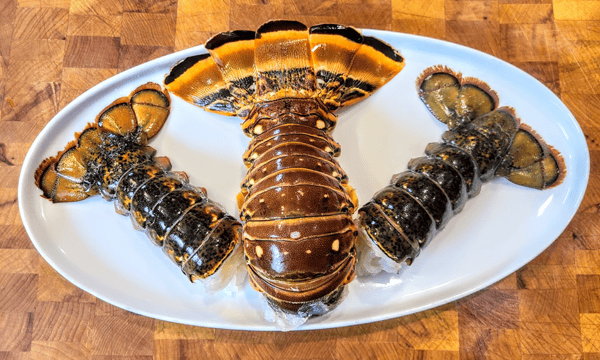 How Can You Tell If it is Warm or Cold-Water Lobster Tails?
How Can You Tell If it is Warm or Cold-Water Lobster Tails?
Ask: The easiest way to find out if the lobster tail you are considering buying is warm or cold water is to ask the fish provider. But often they won’t know, and it isn’t like the packaging says. If they do not know, assume it is warm-water.
Look: Another way to tell the difference between warm and cold-water lobster is by looking at the shells. Typically, the warm water lobsters have black spots on their shells, and the Caribbean warm-water tails have distinct yellow spots and a yellow band across the tail. Cold water tails do not have these markings. Additionally, cold water tails have whiter meat.
Cost: Cold water lobster tails will almost always be more expensive than warm water lobster tails.
Buying Tips
- Avoid buying tails that have any discoloration in the meat. Things to look for are black spots or yellowing on the flesh. Basically, take a close look at the meat itself, and any sign of yellowing or dull or discolored meat should be avoided.
- Check labels or ask fish provider if the tails have been soaked in sodium tripolyphosphate prior to freezing. If so, avoid these tails.
- Tails should not have any grayish color. If they are gray at all, it may mean the lobster was dead before processing, and it will not be a good quality tail.
- Don’t buy thawed lobster tails. Tails should be frozen, and thawed just before cooking. You want to cook right away once thawed.
- Look for lobster tails ranging from 5oz to 12oz. These are smaller tails, and are the prime size for getting a good amount of meat and a quality taste and texture with lobster tails.
- Buy from a reputable place.
- Pay more for the cold water tails. The warm water tails have a 20% chance of being mushy or not great, while the cold-water lobster is almost always great.
- The best time of year to buy lobsters is during the winter when prices tend to be lower.
Now that you got the lowdown on lobsters, lets make chicken fried lobster! I have to admit even though I may not be lobsters’ biggest fan, anything that is fried is going to be delicious. I feel like this is a great starter recipe for lobster newbies to cook at home.
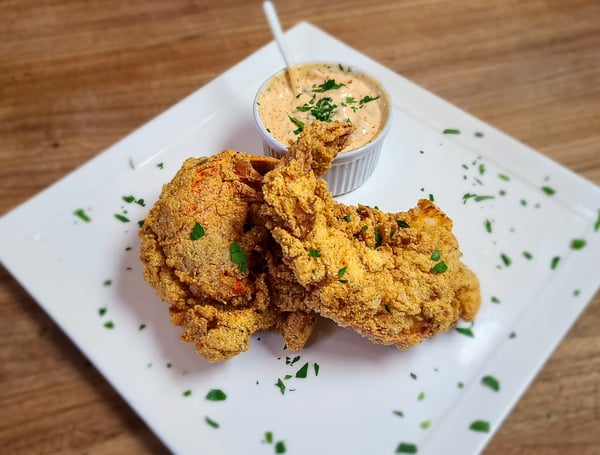
Chicken Fried Lobster
Scroll down for a printable version of this recipe
Yield: 4 tails
Cook time: 6 minutes
Prep time: 15 minutes
Canola oil for frying
3 cups all-purpose flour
1 cup rice flour
1 cup cornmeal
1 1/2 Tablespoons salt
1 Tablespoon ground black pepper
1 teaspoon garlic powder
1/2 teaspoon cayenne pepper
1 cup buttermilk
1/2 teaspoon hot sauce, such as Tabasco
4 lobster tails, thawed
1. Preheat oil in a pot to 365° F. You will want the pot filled about halfway with oil.
2. In a large bowl, mix the all-purpose flour, rice flour, cornmeal, salt, pepper, garlic powder and cayenne pepper. In a separate bowl, mix the buttermilk and hot sauce.
3. Cut the lobster tails in half or cut a slit in the top to pull the tail out and sit on top of the shell.
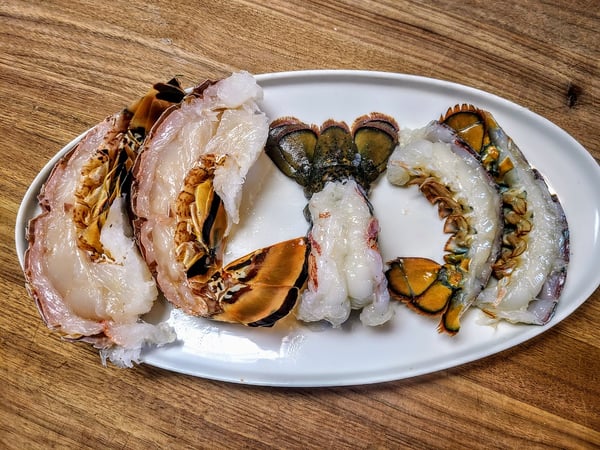 4. Dredge the lobster pieces in the flour mixture and then through the buttermilk mixture. Then dip them again into the flour mixture.
4. Dredge the lobster pieces in the flour mixture and then through the buttermilk mixture. Then dip them again into the flour mixture.
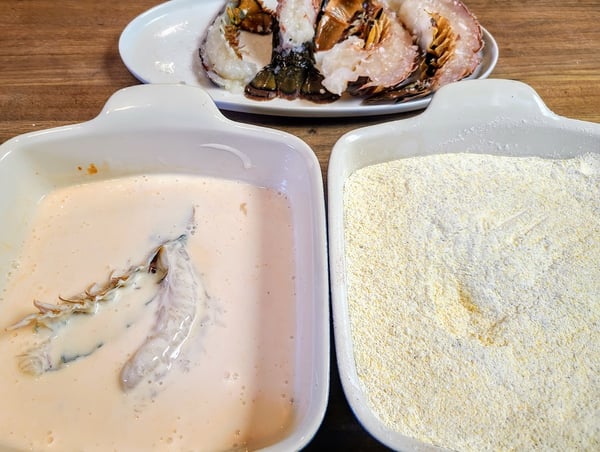 5. Place the lobster in the deep fryer and cook until golden brown, 4 to 5 minutes.
5. Place the lobster in the deep fryer and cook until golden brown, 4 to 5 minutes.
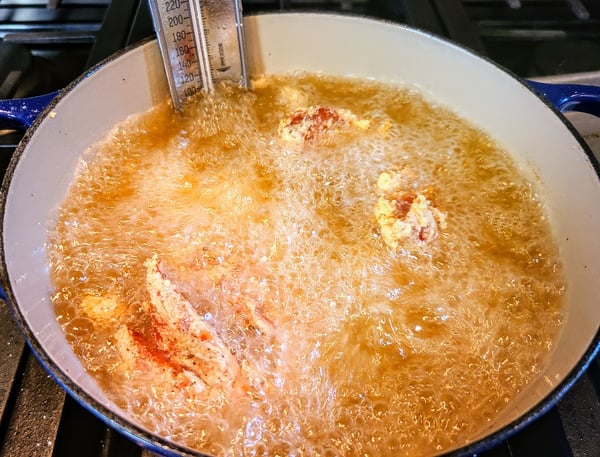 6. Serve with remoulade, or any other favorite sauce.
6. Serve with remoulade, or any other favorite sauce.
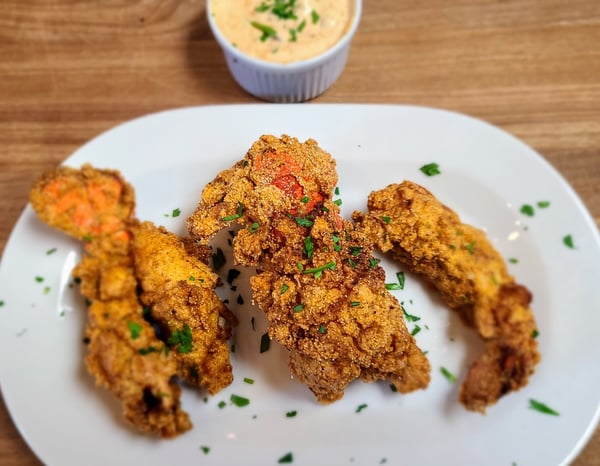
Spicy Remoulade
Yield: 1 cup
1 cup mayonnaise
2 Tablespoons Dijon mustard
1 Tablespoon freshly squeezed lemon juice
1 Tablespoon finely chopped flat-leaf parsley
1 Tablespoon Louisiana-style hot sauce
2 teaspoons whole-grain mustard
2 cloves garlic, minced
2 teaspoons capers, roughly chopped
1 teaspoon Worcestershire sauce
2 teaspoon ancho chili powder
1 scallion, finely chopped
1/4 teaspoon kosher salt
1/8 teaspoon cayenne pepper
- In a small bowl, mix together mayonnaise, Dijon mustard, lemon juice, parsley, hot sauce, whole-grain mustard, garlic, capers, Worcestershire sauce, paprika, scallion, salt, and cayenne pepper. Let sit for 1 hour for flavors to combine, then serve or cover and store in the refrigerator.
Who wouldn’t love lobster prepared this way? It was so crisp on the outside and tender and juicy on the inside. The remoulade provided a nice spice to complement the sweet delicate lobster meat.
I would love to hear your tales of lobster cookery for this weeks #TCBCookingChallenge in our private Facebook group!
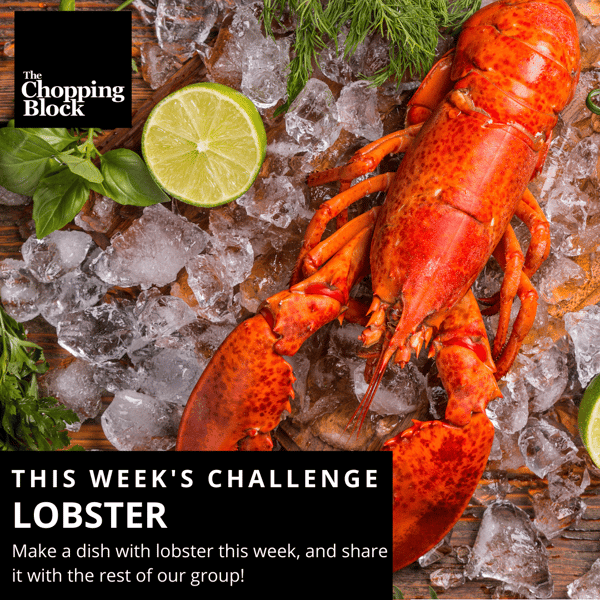 We also have virtual or in-person classes coming up that feature lobster:
We also have virtual or in-person classes coming up that feature lobster:
- Virtual Lobster Rolls on Saturday, July 10 at 6pm CST
- Shellfish on the Grill on Saturday, August 28 at 6:30pm at Lincoln Square
- Virtual Grilled Lobster Thermidor on Sunday, August 29 at 4pm CST
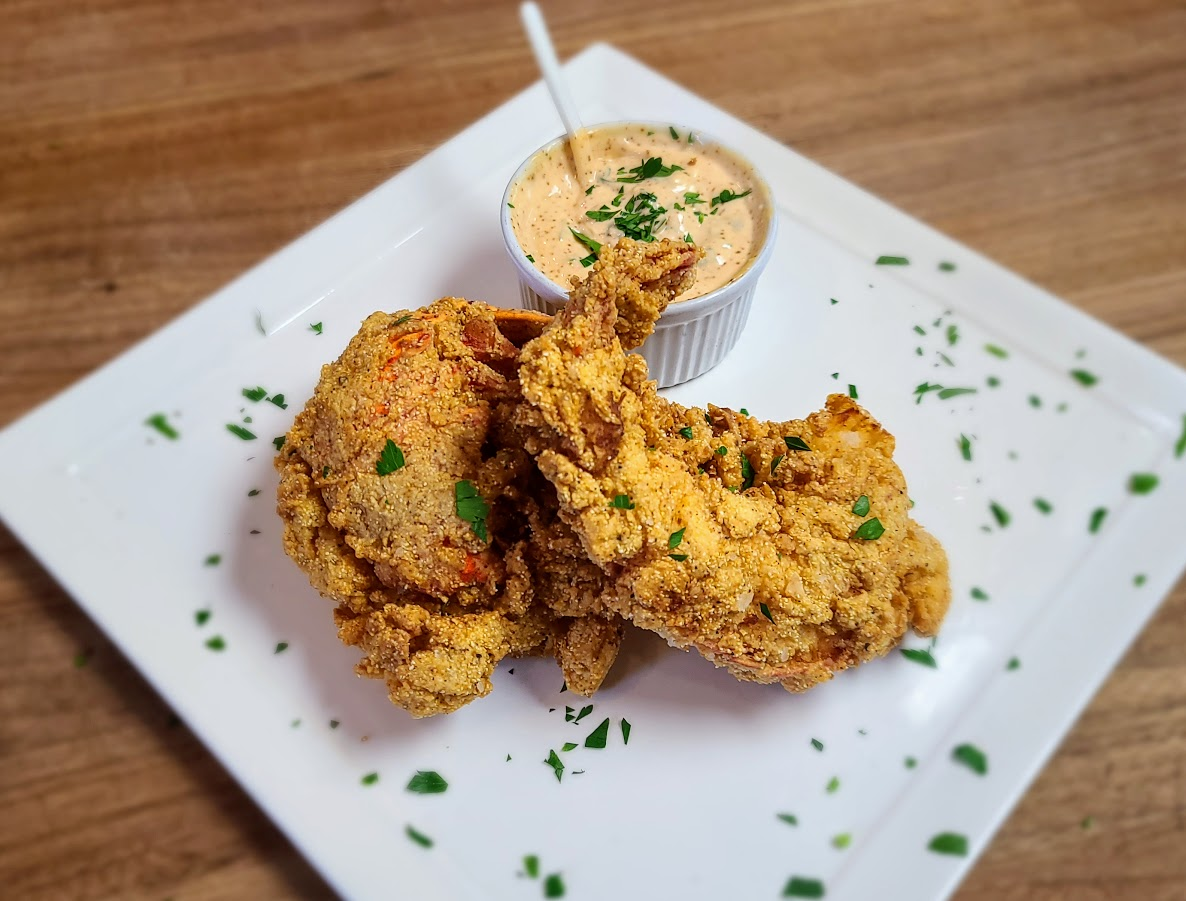
Chicken Fried Lobster
Ingredients
- Canola oil for frying
- 3 cups all-purpose flour
- 1 cup rice flour
- 1 cup cornmeal
- 1 1/2 Tablespoons salt
- 1 Tablespoon ground black pepper
- 1 teaspoon garlic powder
- 1/2 teaspoon cayenne pepper
- 1 cup buttermilk
- 1/2 teaspoon hot sauce, such as Tabasco
- 4 lobster tails, thawed
Instructions
- Preheat oil in a pot to 365° F. You will want the pot filled about halfway with oil.
- In a large bowl, mix the all-purpose flour, rice flour, cornmeal, salt, pepper, garlic powder and cayenne pepper. In a separate bowl, mix the buttermilk and hot sauce.
- Cut the lobster tails in half or cut a slit in the top to pull the tail out and sit on top of the shell.
- Dredge the lobster pieces in the flour mixture and then through the buttermilk mixture. Then dip them again into the flour mixture.
- Place the lobster in the deep fryer and cook until golden brown, 4 to 5 minutes.
- Serve with remoulade, or any other favorite sauce.

